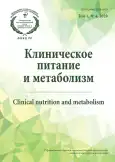Эффективность применения продукта Софтиа Эс компании NUTRI у пациентов с дисфагией
- Авторы: Пряникова Н.И.1, Быкадорова А.А.1, Поликарпова О.С.1, Щелкунова И.Г.2, Петрова М.В.2,3
-
Учреждения:
- Федеральный научно-клинический центр реаниматологии и реаниматологии
- Федеральный научно-клинический центр реаниматологии и реабилитологии
- Российский университет дружбы народов
- Выпуск: Том 1, № 4 (2020)
- Страницы: 156-164
- Раздел: Оригинальные исследования
- URL: https://journals.rcsi.science/2658-4433/article/view/62329
- DOI: https://doi.org/10.17816/clinutr62329
- ID: 62329
Цитировать
Полный текст
Аннотация
Обоснование. Проблема дисфагии различного генеза широко распространена. Опасность данной патологии заключается в высокой вероятности развития грозных осложнений — мальнутриции, дегидратации, снижения веса, обструкции дыхательных путей, аспирационной пневмонии. Для решения проблем с нарушением глотания жидкостей предлагается продукт Софтиа Эс. Данное исследование было профинансировано Министерством сельского, лесного и рыбного хозяйства Японии в рамках Плана сотрудничества из 8 пунктов, представленного премьер-министром Японии С. Абэ президенту Российской Федерации В. В. Путину в мае 2016 г. Цель — оценка эффективности и безопасности применения загустителя Софтиа Эс компании NUTRI для пациентов с дисфагией различного генеза. Материал и методы. В составе комплексной оценки степени выраженности дисфагии пациентам на первом этапе проводилась логопедическая оценка, далее выполнялась видеофлюороскопия и видеоларингоскопия с оценкой функции глотания (прямая ларингоскопия с оценкой нарушения глотания); оценка проводилась по шкалам Rosenbek (PAS) и FEDSS. Рандомизированно пациенты были поделены на 2 равные группы (эксперимент и контроль). Продолжительность исследования составила 14 дней. Ежедневно проводился осмотр логопедом и врачом-диетологом. В 1-й и 14-й дни проводился контроль лабораторных показателей, определение массы тела пациентов. Результаты. В исследование вошли 30 пациентов с дисфагией легкой степени. К концу исследования у 8 человек экспериментальной группы наблюдалось восстановление функции глотания, остаточные явления в виде поперхивания сохранились у 7 человек. В контрольной группе незначительное улучшение наблюдалось у 2 пациентов, в 13 случаях не отмечено изменений в степени дисфагии. Наиболее статистически значимые изменения обнаружены в экспериментальной группе для показателей «Время приема пищи, мин» («Завтрак» в среднем на 3,7 мин, p=0,0033; «Обед» в среднем на 6,9 мин, p <0,0001); «Количество поперхиваний после гидратации» («Завтрак» в среднем на 7,0 мин, p <0,0001; «Обед» в среднем на 8,1 мин, p <0,0001; «Ужин» в среднем на 6,8 мин, p <0,0001); «Количество поперхиваний во время гидратации» («Завтрак» в среднем на 8,8 мин, p <0,0001; «Обед» в среднем на 12,1 мин, p <0,0001; «Ужин» в среднем на 8,7 мин, p <0,0001). В экспериментальной группе также значимо, в отличии от контрольной группы, снизилось число случаев дисфонии с мокротой. Заключение. Таким образом, можно сделать вывод о целесообразности применения Софтиа Эс в составе комплексной терапии дисфагии для облегчения приема пищи у пациентов за счет снижения количества поперхиваний после и во время гидратации, а также времени приема пищи и случаев дисфонии с мокротой.
Ключевые слова
Полный текст
Открыть статью на сайте журналаОб авторах
Наталья Игоревна Пряникова
Федеральный научно-клинический центр реаниматологии и реаниматологии
Автор, ответственный за переписку.
Email: klyaksa451@mail.ru
ORCID iD: 0000-0002-4864-795X
SPIN-код: 4614-4725
врачь логопед, неврологическое отделение нейрореабилитации
Россия, 107031, Москва, ул. Петровка, д. 25, стр. 2Анна Александровна Быкадорова
Федеральный научно-клинический центр реаниматологии и реаниматологии
Email: abykadorova@fnkcrr.ru
ORCID iD: 0000-0003-2113-0456
врач диетолог, приемное консультативно-диагностическое отделение
Россия, 107031, Москва, ул. Петровка, д. 25, стр. 2Олеся Сергеевна Поликарпова
Федеральный научно-клинический центр реаниматологии и реаниматологии
Email: olesiapolikarpova@gmail.com
ORCID iD: 0000-0001-7715-9181
SPIN-код: 5444-7428
врачь логопед, неврологическое отделение нейрореабилитации
Россия, 107031, Москва, ул. Петровка, д. 25, стр. 2Инесса Геннадиевна Щелкунова
Федеральный научно-клинический центр реаниматологии и реабилитологии
Email: ishchelkunova@fnkcrr.ru
ORCID iD: 0000-0002-3778-5417
SPIN-код: 8319-4170
кандидат медицинских наук, заместитель директора по организации медицинской деятельности
Россия, 107031, Москва, ул. Петровка, д. 25, стр. 2Марина Владимировна Петрова
Федеральный научно-клинический центр реаниматологии и реабилитологии; Российский университет дружбы народов
Email: mpetrova@fnkcrr.ru
ORCID iD: 0000-0003-4272-0957
SPIN-код: 9132-4190
доктор медицинских наук, профессор, заместитель директора по научно-клинической деятельности
Россия, 107031, Москва, ул. Петровка, д.25, стр.2; 117198, Москва, ул. Миклухо-Маклая, 6Список литературы
- Ивашкин В.Т., Маев И.В., Трухманов А.С., и др. Клинические рекомендации Российской гастроэнтерологической ассоциации по диагностике и лечению дисфагии // Российский журнал гастроэнтерологии, гепатологии, колопроктологии. 2015. № 5. С. 84–93. [Ivashkin VT, Mayev IV, Trukhmanov AS, et al. Diagnostics and treatment of dysphagia: clinical guidelines of the Russian gastroenterological association. Russian Journal of Gastroenterology, Hepatology, and Coloproctology. 2015;(5): 84–93. (In Russ).]
- WGO Global Guidelines. Практические рекомендации Всемирной гастроэнтерологической организации «Дисфагия». World Gastroenterology Organisation; 2014. [WGO Global Guidelines. Practical recommendations of the World Gastroenterological Organization «Dysphagia». World Gastroenterology Organisation; 2014. (In Russ).] Режим доступа: http://www.worldgastroenterology.org/UserFiles/file/guidelines/dysphagia-russian-2014.pdf. Дата обращения: 15.07.2020.
- Holland G, Jayasekeran V, Pendleton N, et al. Prevalence and symptom profiling of oropharyngeal dysphagia in a community dwelling of an elderly population: a self-reporting questionnaire survey. Dis Esophagus. 2011;24(7): 476–480. doi: 10.1111/j.1442-2050.2011.01182.x
- Turley R, Cohen S. Impact of voice and swallowing problems in the elderly. Otolaryngol Head Neck Surg. 2009;140(1):33–36. doi: 10.1016/j.otohns.2008.10.010
- Lin LC, Wu SC, Chen HS, et al. Prevalence of impaired swallowing in institutionalized older people in Taiwan. J Am Geriatr Soc. 2002;50(6):1118–1123. doi: 10.1046/j.1532-5415.2002.50270.x
- Диагностика и лечение дисфагии при заболеваниях центральной нервной системы: клинические рекомендации. Под ред. Стаховской Л.В., Мельниковой Е.В. Москва, 2013. [Stakhovskaya LV, Melnikova EV, ed. Diagnosis and treatment of dysphagia in diseases of the central nervous system: clinical recommendations. Moscow; 2013. (In Russ).] Режим доступа: https://rehabrus.ru/Docs/Disfagia_last.doc. Дата обращения: 15.07.2020.
Дополнительные файлы







